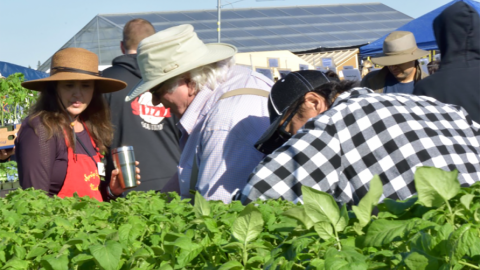Tips from a Master Gardener for Growing Bay Area Tomatoes
Mary Collins has been a Master Gardener for 18 years and is in charge of growing the 60 varieties of tomatoes for this year’s UC Master Gardeners Spring Garden Sale on April 15.
We caught up with Mary as she was directing a group of Master Gardeners to “up pot” seedlings and while she watered everything in the greenhouse. We asked her to highlight a few of the exclusive tomato plants that will be offered at the sale, and to share a little bit about their origins.
One unusual tomato is the “Brandywine from Croatia.” Back before the health department stepped in, the Master Gardeners offered tomato tasting. A member of the public brought a tomato that had come from seeds their relatives grew in Croatia. It was such a hit with its meaty texture and complex flavor that the Master Gardeners started saving the seeds to grow seedlings for the public. The April Spring Garden Fair is the only place “Brandywine from Croatia” can be found.
Returning for sale this year is another surprise standout tomato plant, “Ed’s Millennium.” There was once a prolific Master Gardener named Ed Lo who found a “volunteer” tomato of unknown origin growing in his garden in the year 2000. It did not match anything he was growing. Where did it come from? That mystery was never solved, but he brought this beefsteak tomato to his fellow Master Gardeners to sample, and it was an instant hit. Now it’s back in the garden sale for you to purchase and grow.
Calling for Test Gardeners!
Interested in testing a future UC Master Gardener tomato plant favorite? Mary also told us about a unique opportunity this year for local gardeners to be testers for two new varieties of tomatoes. A small number of these test tomato plants are available at the plant sale for gardeners who promise to share their experiences with the Master Gardeners. Tomatoes that make the grade could be offered at next year’s sale.
Tomato Growing Tips
Once you’ve selected your tomato variety and plants, it’s time to get growing. We asked Mary to share some of her knowledge and best tips for Bay Area tomato gardening with us.
To start, she reminded us that when shopping for any tomato, it’s the color of the tomato fruit that tells you about its taste. Yellow and orange tomatoes are sweeter, while red tomatoes have a more acidic taste. Paste tomatoes are best for sauces. She recommends “Principe Borghese Tomato” as a great choice for growing and making sun-dried tomatoes.
And the best tomato for eating right out of the garden over the kitchen sink? To this she advises, “Whatever is ripe!”![]()
When you purchase your tomato seedling from the event or from a nursery, remember that it is coming from a protected and shady greenhouse. It needs protection from shock before you plant it in the ground or in a container. This is called “hardening off.” When you bring it home, keep it outside in a covered area for a few days. Then move it to the sun for a few more days. After that, move it for a little while to the area where it will ultimately be planted. Finally, plant it in your garden or container. This process takes about two weeks.
Which brings us to her next point: Don’t plant until after May 1. That’s why the Master Gardeners garden sale is always held the second week of April. By early May, the soil should be warmer and ready to support the plant.
Be careful of adding too much fertilizer, she says. Many gardeners add too much nitrogen to their soil, which results in tall, vigorous and leafy plants—but little fruit. She just adds worm castings and alfalfa pellets to her garden.
One of the biggest mistakes is overwatering tomatoes. Too much water results in watery tomatoes. Mary stops most watering when the tomatoes are on the vine, only adding water if the weather has been unseasonably hot. She suggests using a soil moisture meter or simply digging down at least three inches to feel the soil. The soil should not be wet or dry, just moist.
Mary offers a rather unusual tip to increase the tomato yield and pollination: In the garden, bees are more attracted to colorful flowers, so they may skip your tomato plants. Mary realized she might need to give her blossoms a little help to pollinate her tomatoes. She hand-pollinates with an electric- or battery-powered toothbrush. By setting the speed on low and placing it right above the blossom, the vibrations cause the pollen to drop among the other flowers.
What's the best tomato for eating right out of the garden over the kitchen sink? “Whatever is ripe!” - Mary Collins, UC Master Gardener
Get your tomato questions answered and make selections from a plentiful array of tomato plants and other summer favorites at the UC Master Gardeners Spring Garden Sale on April 15. Read more about the event here.



